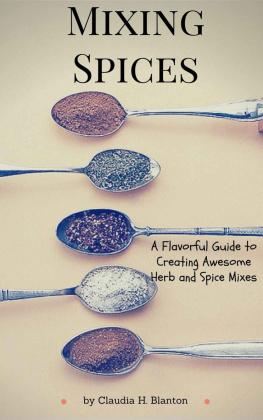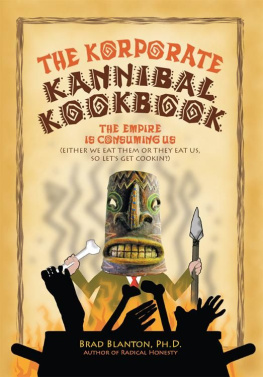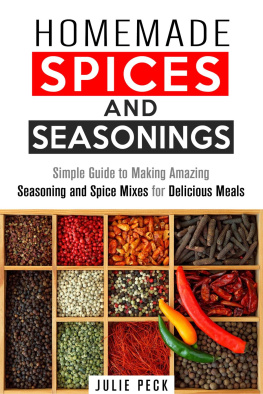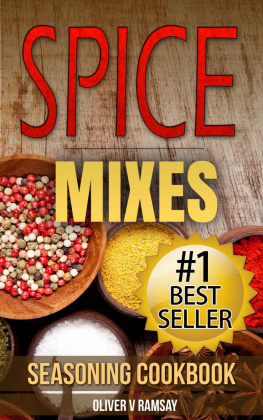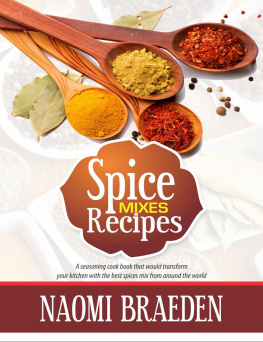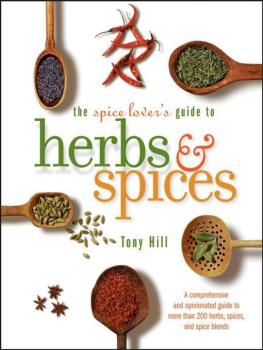Blanton - Mixing Spices: A Flavorful Guide To Creating Awesome Herb And Spice Mixes
Here you can read online Blanton - Mixing Spices: A Flavorful Guide To Creating Awesome Herb And Spice Mixes full text of the book (entire story) in english for free. Download pdf and epub, get meaning, cover and reviews about this ebook. year: 2015, genre: Home and family. Description of the work, (preface) as well as reviews are available. Best literature library LitArk.com created for fans of good reading and offers a wide selection of genres:
Romance novel
Science fiction
Adventure
Detective
Science
History
Home and family
Prose
Art
Politics
Computer
Non-fiction
Religion
Business
Children
Humor
Choose a favorite category and find really read worthwhile books. Enjoy immersion in the world of imagination, feel the emotions of the characters or learn something new for yourself, make an fascinating discovery.
- Book:Mixing Spices: A Flavorful Guide To Creating Awesome Herb And Spice Mixes
- Author:
- Genre:
- Year:2015
- Rating:3 / 5
- Favourites:Add to favourites
- Your mark:
- 60
- 1
- 2
- 3
- 4
- 5
Mixing Spices: A Flavorful Guide To Creating Awesome Herb And Spice Mixes: summary, description and annotation
We offer to read an annotation, description, summary or preface (depends on what the author of the book "Mixing Spices: A Flavorful Guide To Creating Awesome Herb And Spice Mixes" wrote himself). If you haven't found the necessary information about the book — write in the comments, we will try to find it.
Mixing Spices: A Flavorful Guide To Creating Awesome Herb And Spice Mixes — read online for free the complete book (whole text) full work
Below is the text of the book, divided by pages. System saving the place of the last page read, allows you to conveniently read the book "Mixing Spices: A Flavorful Guide To Creating Awesome Herb And Spice Mixes" online for free, without having to search again every time where you left off. Put a bookmark, and you can go to the page where you finished reading at any time.
Font size:
Interval:
Bookmark:
Mixing Spices Mixing Spices A Flavorful Guide to Creating Awesome Herb And Spice Mixes by Claudia H. Blanton  Contents: 1. The Basics 2. Spice Substitutions 3. Herb Substitutions 4. Types of Salts 5.
Contents: 1. The Basics 2. Spice Substitutions 3. Herb Substitutions 4. Types of Salts 5.
Types of Peppers 6. Basic Blends 7. Rubs And Salts 8. Mixes From Around The World 9. Misc. Blends Dedicated to my husband who shared with me his love for creating the most amazing dishes from all around the world.
You spoil me. I love you The Basics Introduction Spices turn food into an experience for the senses. A delicious dance of flavors, that awakens our tongue, sometimes shocking our system, sometimes calming it. Stepping into the world of spices and the endless ways to combine them to create even more spectacular experiences, it turns mere cooking into an art form. Traditional and regional spice mixes vary greatly around the world, largely depending on the original availability and what flavors work best with the foods available in that region. Other times, herbs and spices kept food from spoiling, and their mixes where used more because of safety for their consumers, rather than to engage into a sensual experience.
This book will give you an overview of some of the basic and common spice mixes, and how you can create them, as well as take you on a journey through some flavors you might not be familiar with. Allow yourself to experience and experiment. Spice Substitutions Not always do we have every spice needed in a blend available to us. For these times, I have included a list of potential substitutions that will not effect the flavor greatly and complement the result you are trying to create. Allspice - cinnamon, gloves or nutmeg Aniseed - fennel seed Cardamom- Ginger Chili powder - oregano and cumin with a pinch of dried red pepper flakes Cinnamon - Nutmeg and allspice combination Cumin -Chili powder Ginger - allspice Mace - cinnamon Dried or ground mustard - wasabi powder, but only half of the amount! Saffron - a dash of turmeric Turmeric-annato powder Herb Substitutions Basil - oregano or thyme Chervil - tarragon Cilantro -parsley Marjoram - thyme or savory Mint - basil or rosemary Oregano - half thyme/half basil Red pepper flakes - black pepper Rosemary - tarragon or savory Sage- marjoram Savory - half thyme/half sage Tarragon - a dash of fennel seeds or chervil Thyme - oregano or basil Weird And Interesting Facts About Vegetables, Herbs, Spices Weird And Interesting Facts About Herbs And Spices 1. Squash is actually a fruit 2.
Broccoli and Cauliflower are the only vegetables that are also flowers 3. Earthworms pair well with cumin and curry. 4. Nutmeg can cause hallucinations and delusions in high enough doses 5. The wasabi sold in the United States is mostly horseradish with food coloring added to it. 6.
The only spice plants that is native to all 48 contiguous states, is Sumac. 7. Black garlic - the fermented version of regular garlic - is associated with Immortality in Taoist Mythology 8. Herbs are derived from the plants leaves, while spices are derived from the seeds, bark, buds and roots of a plant. Salts Table Salt: Food grade table salt - the one you can get in any grocery store in the US - is almost purely sodium chloride, usually 97 % or higher It comes in two varieties - one with and one without iodine. Iodine was introduced as a preventive measure against iodine deficiency, a still common health threat around many parts of the world, causing hypothyroidism, mental retardation and other health problems.
For more information on what a lack of iodine in a diet can do to a body, visit WebMD http://www.webmd.com/drugs/condition-684-Iodine+Deficiency.aspx?diseaseid= 684&diseasename=Iodine+Deficiency If you are choosing to use the non-iodized version of table salt or any of the other salts mentioned in this section, make sure you are eating a diet high in iodine to prevent health problems. Most standard table salts include an anti-clumping agent to prevent caking. Sea Salt
A widely available type of salt. It is derived from evaporating seawater. While it usually contains trace amount of minerals like zinc, iron and potassium, it can also contain the pollutants found in the area it was harvested from. Darker sea salt contains the most of both, which could mean that it possibly contains lead and other heavy metals.
When used in the kitchen it is often preferred because of its texture, often less ground than regular, refined table salt creating a different "mouth-feel". Check out different brands, as the minerals and impurities affect the taste of the salt, which can greatly influence your mixtures and blends. Himalayan Pink Salt
Harvested in Pakistan at the Khewra Salt Mine, the Himalayan salt gets is color from the trace amounts of iron oxide (yes, rust). It has a slightly lower amount of sodium than regular salt. The most obvious difference between this salt and the others is of course the color, which makes it a good salt to create blends to give as a gift. The taste is very similar of the regular salt on its own, and virtually the same when mixed in with your dishes.
Use as garnish. Coarser than regular table salt, so again that creates a slightly different texture. You can get this type of salt in specialty stores, or on-line. Kosher Salt As it's name suggests, this salt was originally created for religious reasons. Because of the structure difference (it is more flaky), many cooks and Chefs prefer this type of salt. It's different texture allows it to be picked up easily when needing a pinch, and it gives a different burst of flavor, when used as a sprinkle over the finished dish.
However, when used in cooking, there is no difference in the end result, compared to table salt. I prefer this type of salt to create the mixes, I want to store for a short period of time, because of its lack of caking agent, which makes it more susceptible to clumping, especially in climates with high humidity like Florida. For all of the other mixes I switch between iodine-table salt, and Celtic salt. Celtic Salt Celtic salt is very unique, as it contains a bit of water which makes it somewhat moist, and it has a grayish color. With a little bit less sodium and a coarser texture, it works well with blends and mixes. Kala Namak Salt This salt originates in India, and also is called black salt at times.
It tastes similar to salted, boiled eggs when eaten on its own, which makes it a favorite in the Vegan community. A little strange, but not as bad as it sounds. Fleur De Sel / Pyramid Salt Nicknamed after its pyramid shape, this salt is the most expensive and rare salt in the world. The daily harvest amounts to only about 60 kg ( 132 pounds). Peppers Black Pepper Strongest and most common of them all. In order to get the most pungent flavor, grind it fresh every time.
Peppers are berries, and underneath the hull of the black pepper hides a slightly lighter colored seed, which is the reason freshly ground pepper can look speckled. Depending on what you are using the spice for, you can grind them fine or coarse. For the sake of most mixes covered in this book, a coarse ground pepper would be the best, unless specifically stated otherwise. Green pepper: Green peppercorns are not ripe peppercorns and are often frozen to preserve their color, or placed in a brine to give them a longer shelf-life. Their flavor is strong, but has a much more subtle finish. They are excellent for meat sauces, poultry or vegetables.
White pepper: White pepper is pepper that had its husk removed. It's seed is then dried.This type of pepper is perfect for white sauces, fish, and vegetable dishes that require a more delicate flavor. Red Peppercorns:
These are actually not from the same plant as peppercorns mentioned above, but from a tree related to the rosebush. Just like it's pink cousin, this type of "pepper" is rare in the US, and is very similar in flavor to black pepper. You can substitute any recipe calling for it with black pepper. Tools: To create great herb spice mixes, all you need, for the most part, are high quality ingredients, a mixing bowl, a spoon and an airtight container to keep them in.
Font size:
Interval:
Bookmark:
Similar books «Mixing Spices: A Flavorful Guide To Creating Awesome Herb And Spice Mixes»
Look at similar books to Mixing Spices: A Flavorful Guide To Creating Awesome Herb And Spice Mixes. We have selected literature similar in name and meaning in the hope of providing readers with more options to find new, interesting, not yet read works.
Discussion, reviews of the book Mixing Spices: A Flavorful Guide To Creating Awesome Herb And Spice Mixes and just readers' own opinions. Leave your comments, write what you think about the work, its meaning or the main characters. Specify what exactly you liked and what you didn't like, and why you think so.

